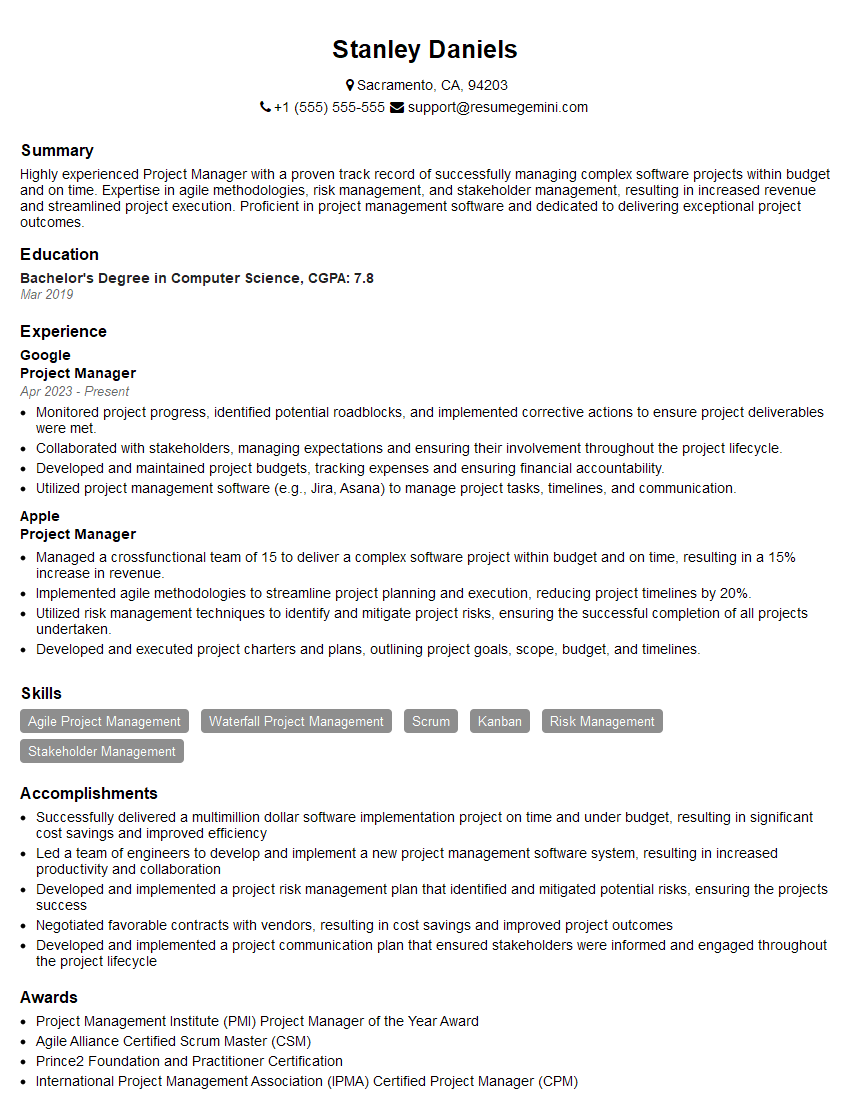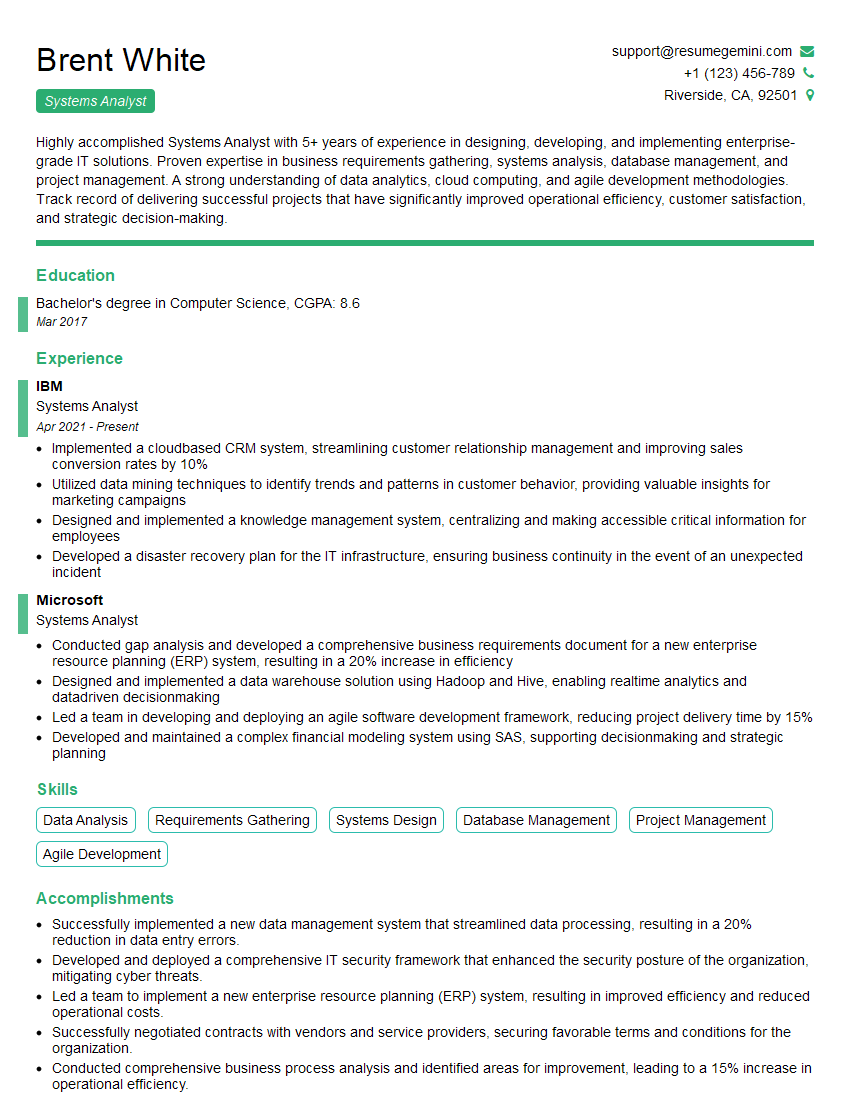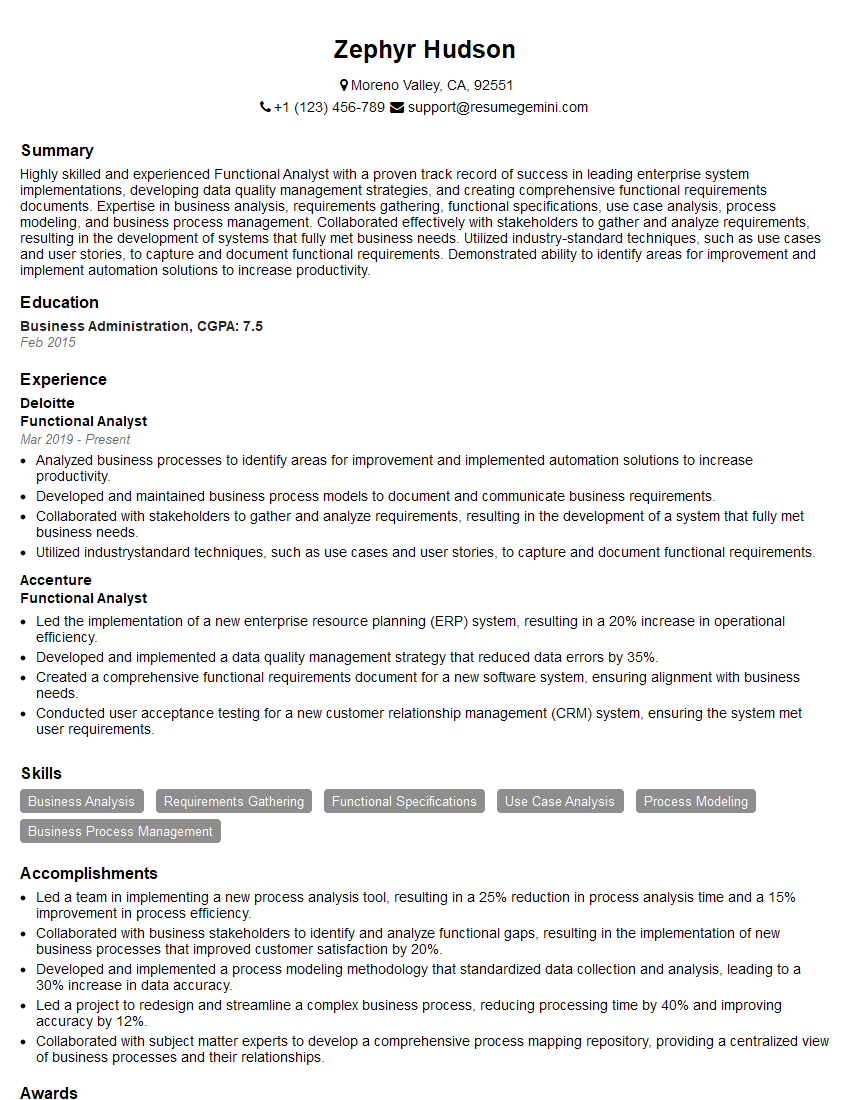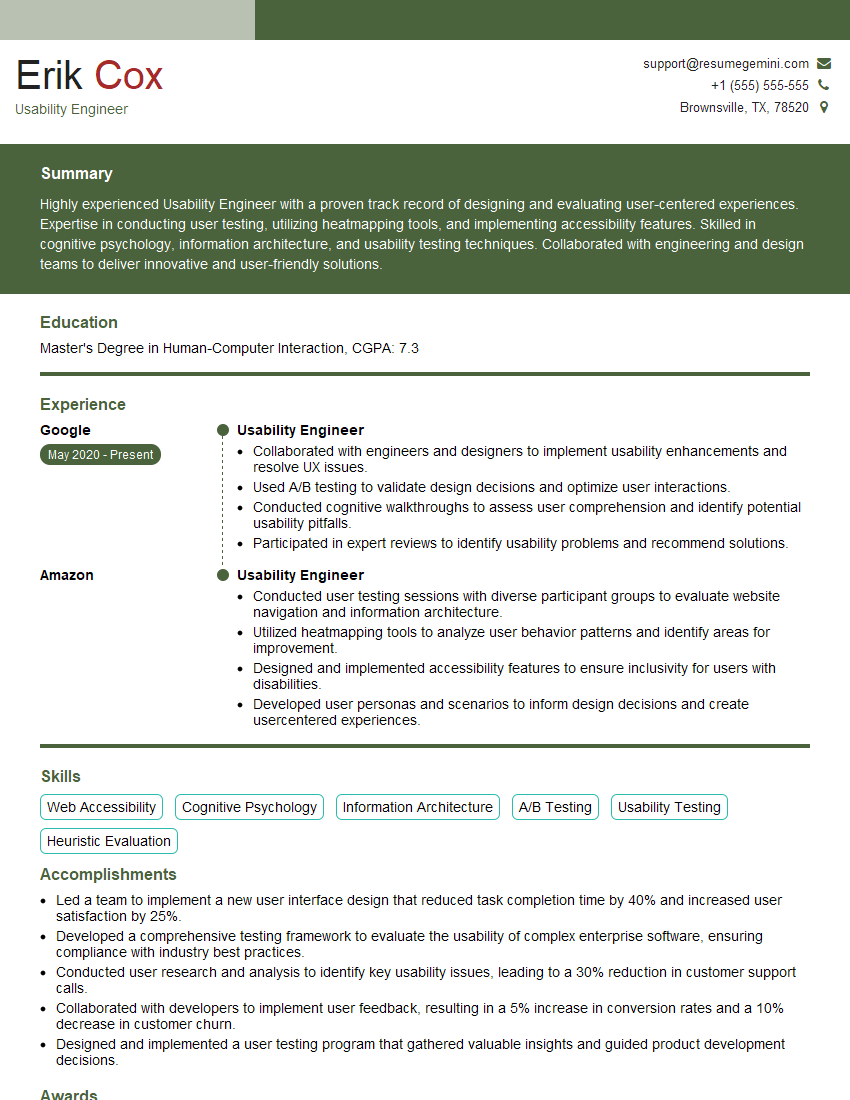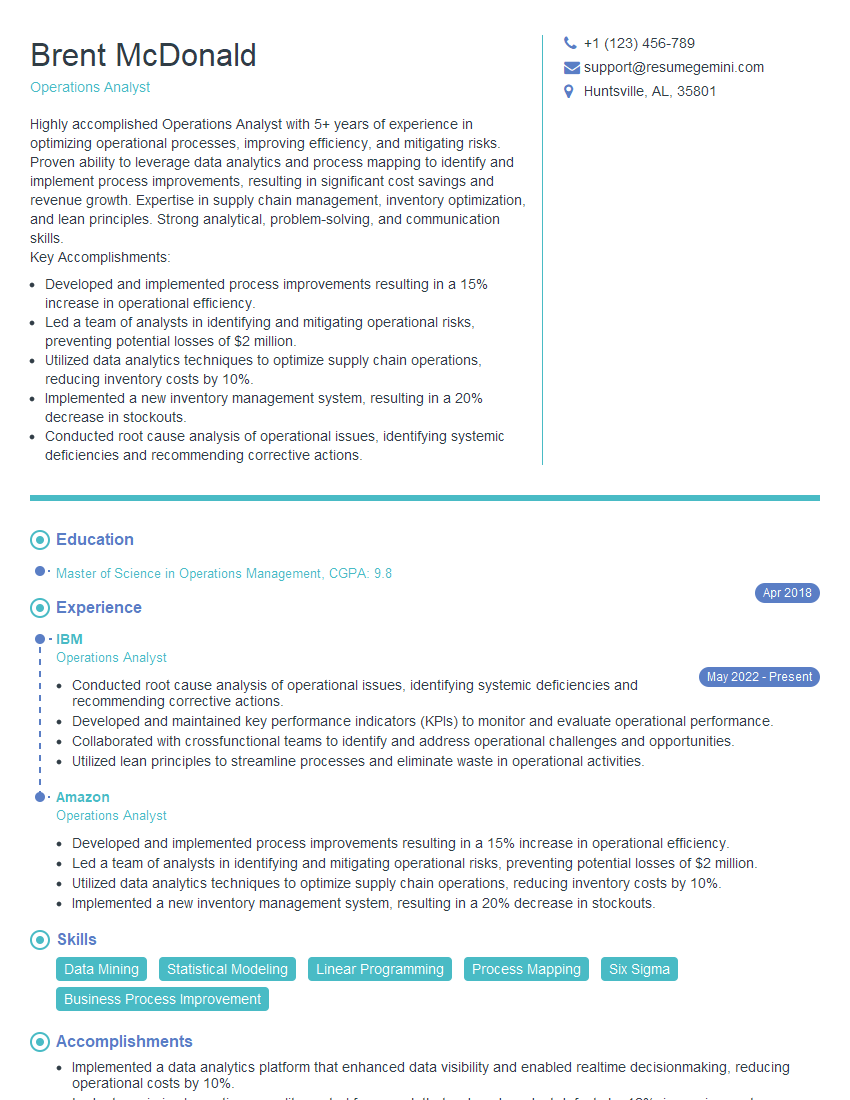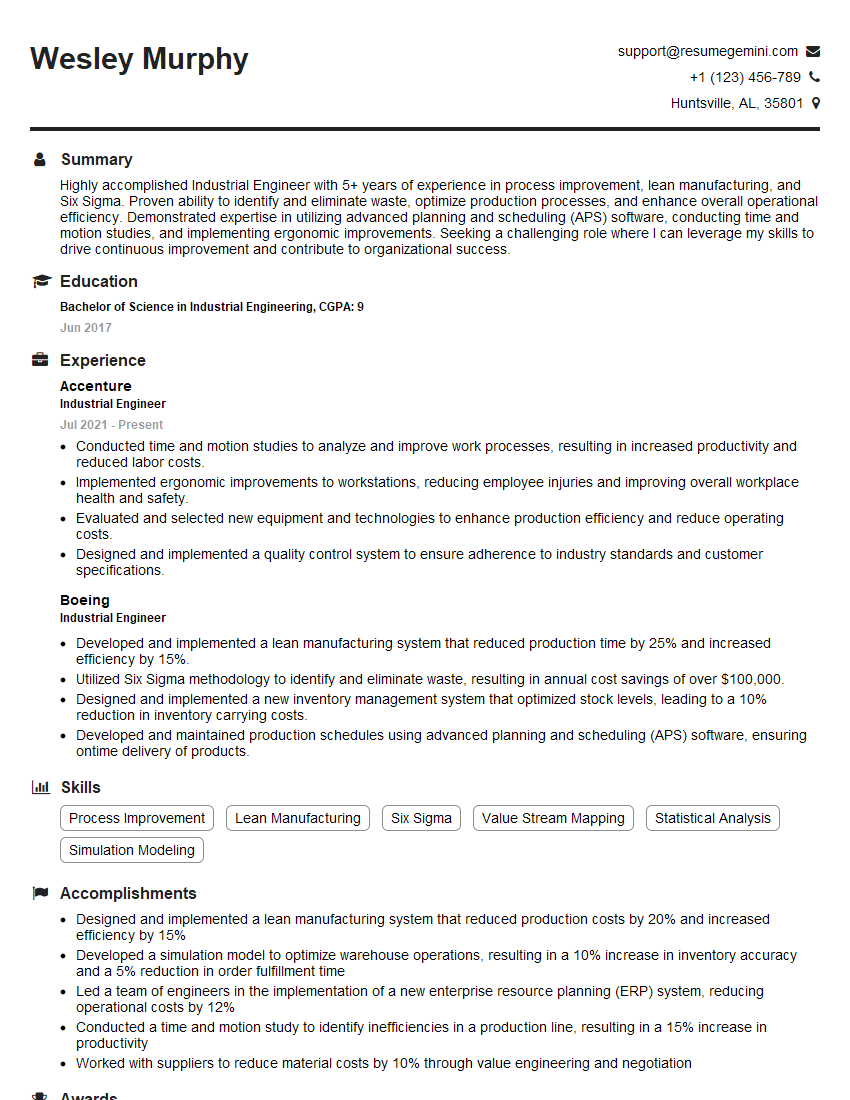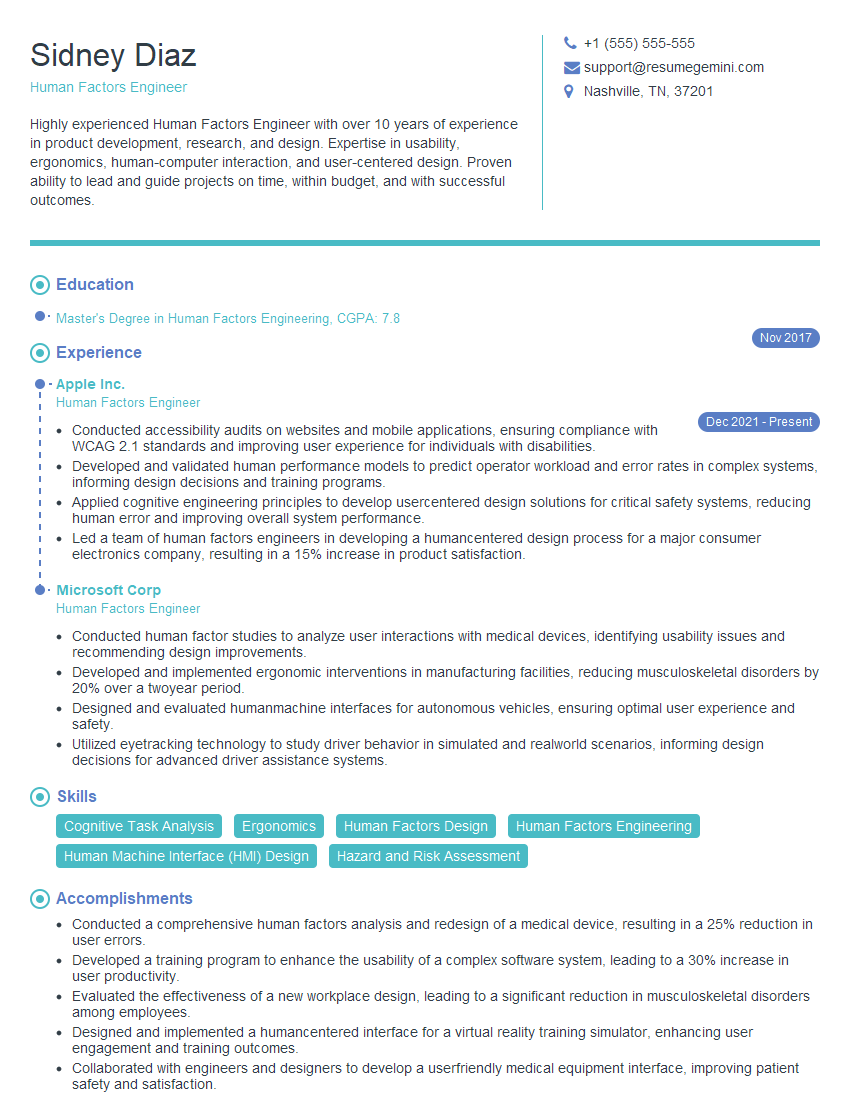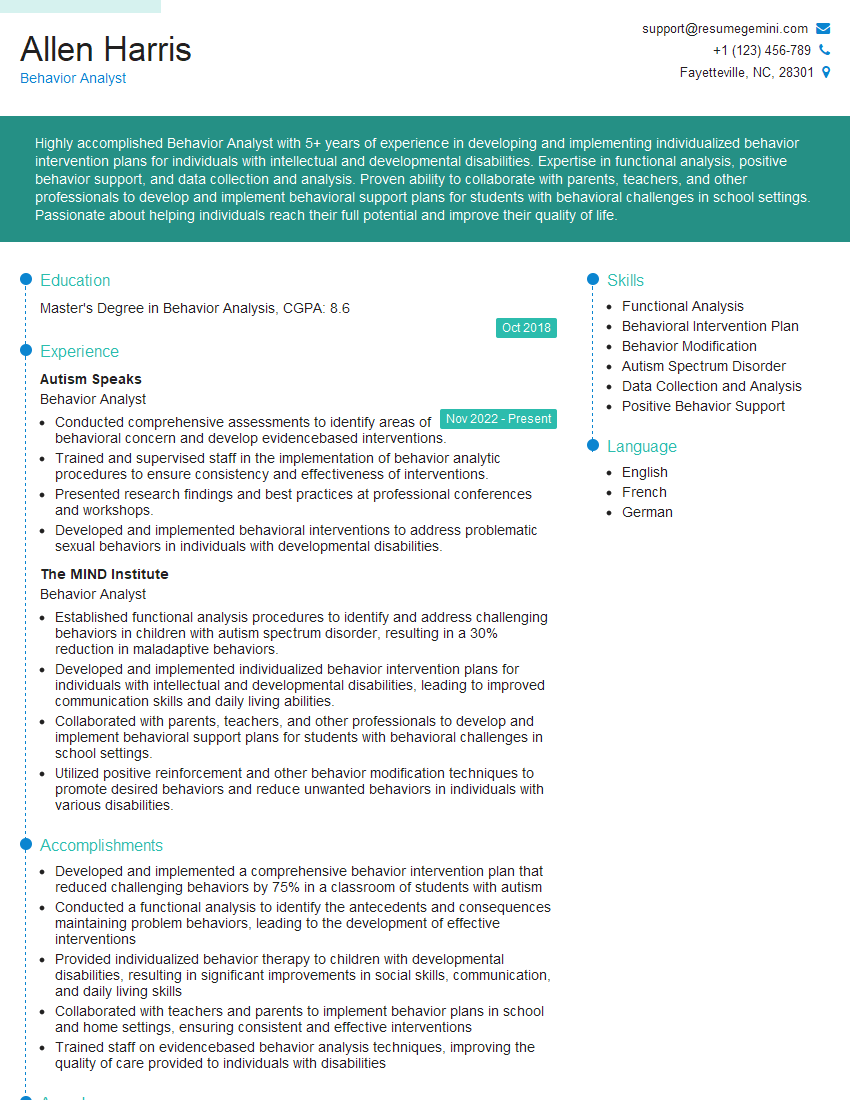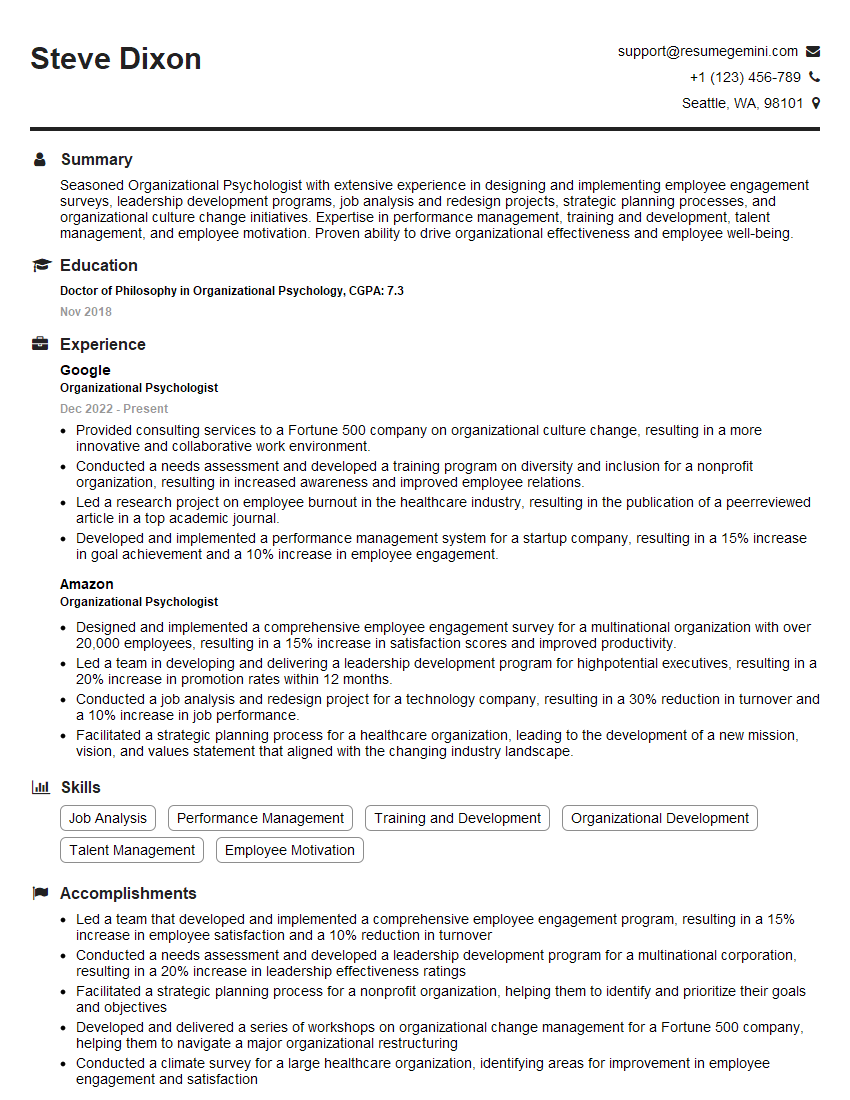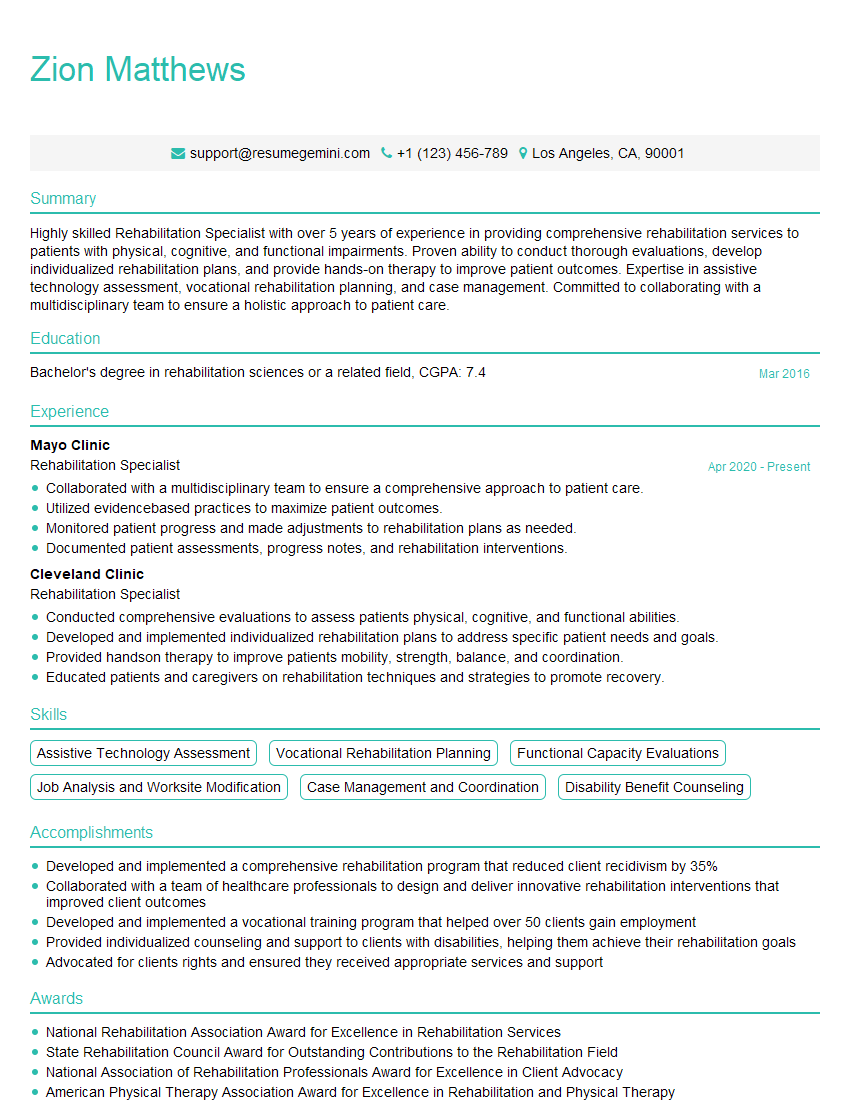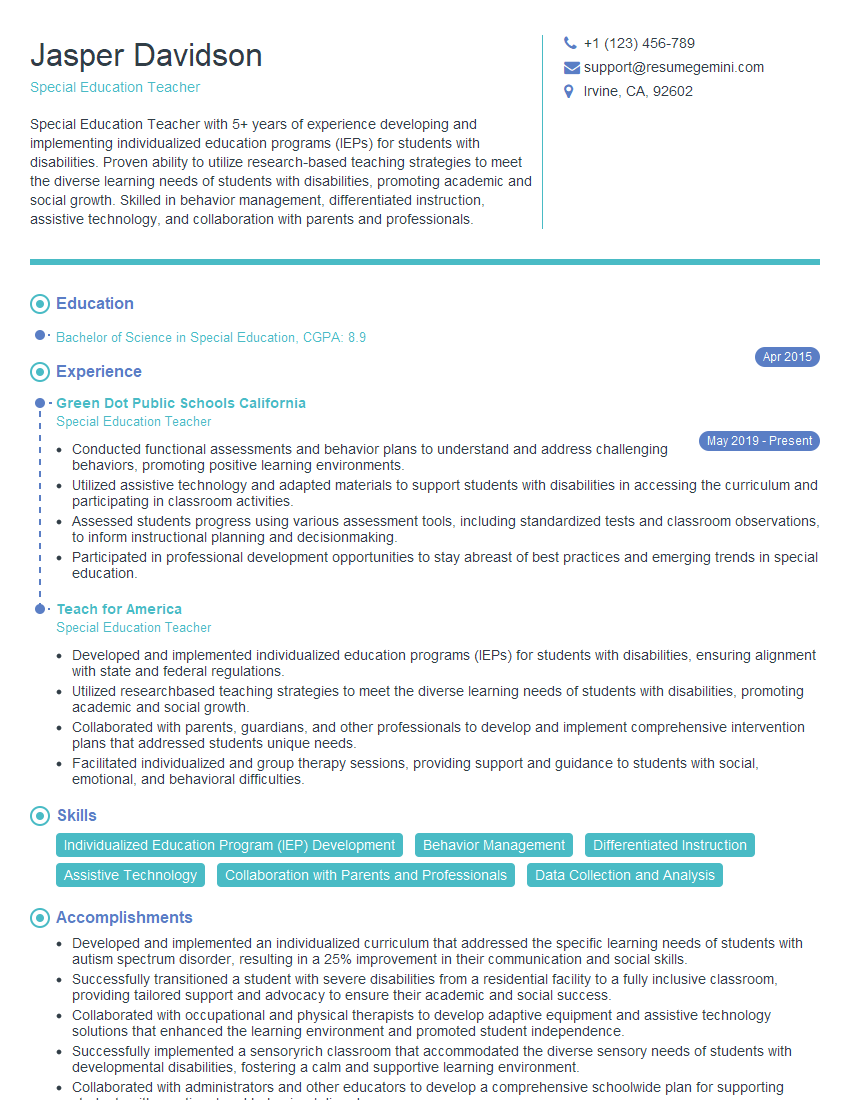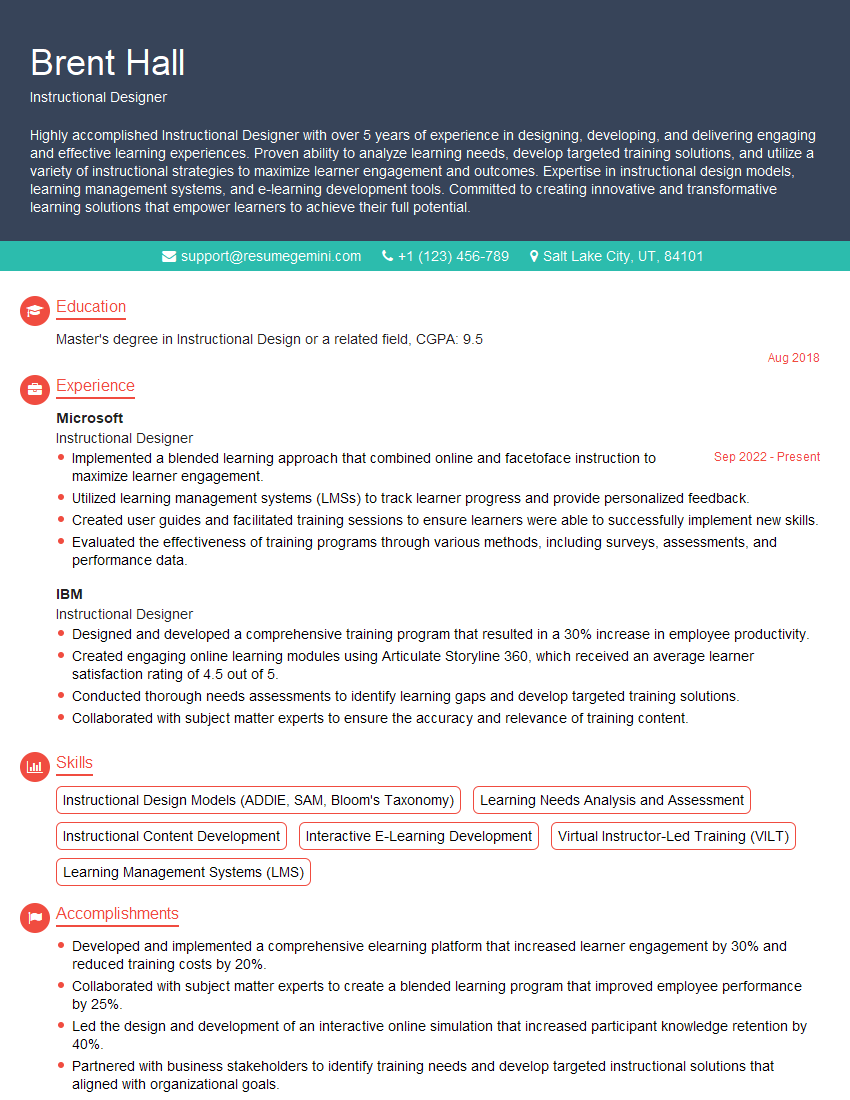Preparation is the key to success in any interview. In this post, we’ll explore crucial Functional Assessment and Task Analysis interview questions and equip you with strategies to craft impactful answers. Whether you’re a beginner or a pro, these tips will elevate your preparation.
Questions Asked in Functional Assessment and Task Analysis Interview
Q 1. Define Functional Assessment and explain its purpose.
Functional Assessment (FA) is a systematic process used to understand why a person engages in a particular behavior. It’s not about judging the behavior itself, but about figuring out the function—the purpose the behavior serves for the individual. Think of it like detective work: we’re trying to solve the mystery of why a behavior is happening. The purpose of a Functional Assessment is to identify the triggers (antecedents) and consequences that maintain the behavior, allowing us to develop effective interventions that address the underlying problem instead of just suppressing the symptoms.
For example, a child might be screaming (the behavior) because it gets them attention from their parents (the consequence). Understanding this helps us develop strategies that provide positive attention when the child is behaving appropriately, making screaming less effective and thus less frequent.
Q 2. Describe the steps involved in conducting a Functional Behavior Assessment (FBA).
Conducting a Functional Behavior Assessment (FBA) involves several crucial steps:
- Defining the Target Behavior: Clearly and objectively define the behavior you’re assessing. Use observable and measurable terms. For example, instead of “acting out,” specify “hitting others,” “throwing objects,” or “verbally abusing classmates.”
- Data Collection: Gather information about the behavior using a variety of methods (discussed in the next question). This helps paint a comprehensive picture of when, where, and why the behavior occurs.
- Hypothesis Development: Based on the collected data, develop a hypothesis about the function of the behavior. This is an educated guess about what the individual is gaining by engaging in the behavior (e.g., attention, escape from a task, access to a desired item).
- Intervention Development: Design an intervention based on your hypothesis. This should address the function of the behavior by providing alternative ways to meet the individual’s needs. For example, if attention is the function, teach appropriate ways to get attention.
- Intervention Implementation and Evaluation: Implement the intervention and monitor its effectiveness. Continuously collect data to assess whether the intervention is reducing the target behavior. Adjust the intervention as needed.
Q 3. What are the different methods used to collect data for a Functional Assessment?
Several methods are used to collect data for a Functional Assessment:
- Indirect Assessment: This involves gathering information from interviews, questionnaires, and rating scales from individuals who know the person well (e.g., parents, teachers, caregivers). This provides background information and contextual clues.
- Direct Assessment: This involves directly observing and recording the behavior as it naturally occurs. Methods include:
- ABC Data Collection: Recording the Antecedent (what happened before the behavior), Behavior (the behavior itself), and Consequence (what happened after the behavior) for each instance of the behavior.
- Descriptive A-B-C recording: Narratives of behavior events providing richer context.
- Scatterplot: Tracking the behavior across time to identify patterns and potential triggers.
- Functional Analysis: A more controlled method where the antecedents and consequences are systematically manipulated to determine their effect on the behavior. This often involves structured experimental conditions.
Q 4. Explain the difference between direct and indirect assessment methods.
The key difference lies in how data is collected. Indirect assessment relies on reports from others about the behavior. It’s relatively quick and easy, but can be subjective and less accurate. Direct assessment involves directly observing and recording the behavior, providing more objective and reliable data. It is more time-consuming but provides more accurate details. Think of it like this: Indirect assessment is like hearing a story about a crime from witnesses; direct assessment is like watching security camera footage of the crime.
Q 5. How do you analyze data collected during a Functional Assessment?
Data analysis involves looking for patterns and relationships between the antecedents, behavior, and consequences. For ABC data, we look for consistent patterns. For example, if a student’s disruptive behavior (hitting) always occurs immediately after a difficult math problem (antecedent) and results in removal from the classroom (consequence), we might hypothesize that the behavior functions as escape from the task. Statistical analysis may be used with larger datasets. Graphing data can visually represent patterns, making it easier to identify trends and relationships. The goal is to identify the most likely function of the behavior based on the available data.
Q 6. What is a Functional Behavioral Analysis (FBA) report and what should it include?
A Functional Behavior Assessment (FBA) report summarizes the findings of the assessment. It should include:
- Identifying Information: The individual’s name, age, and relevant background information.
- Target Behavior Definition: A clear and concise definition of the behavior being assessed.
- Assessment Methods Used: A description of the data collection methods used (e.g., ABC data, interviews, questionnaires).
- Data Summary: A presentation of the collected data, including graphs and tables if appropriate.
- Hypothesis: A statement summarizing the hypothesized function of the behavior.
- Recommendations: Specific, practical, and data-driven recommendations for interventions to address the behavior.
A well-written FBA report should be easily understood by those involved in the individual’s care and should clearly communicate the rationale for the recommended interventions.
Q 7. What is Task Analysis and how does it relate to Functional Assessment?
Task Analysis is a process of breaking down a complex skill or task into smaller, more manageable steps. It’s closely related to Functional Assessment because it can be used to create interventions. If a behavior serves to escape a task, understanding the task itself through task analysis allows us to break it down to more manageable steps, making the task less aversive and reducing the need for escape behaviors. For example, if a student avoids writing essays because it’s overwhelming, task analysis could break it into steps like brainstorming ideas, creating an outline, writing an introduction, etc. Then you can teach each step, and provide reinforcement for completion.
Essentially, task analysis helps us design interventions that modify the environment (the task itself) to address the behavior. This complements the FBA, which identifies the function of the behavior, by offering specific strategies to modify the environment to reduce the likelihood of the problem behavior.
Q 8. Describe different methods of Task Analysis.
Task analysis involves breaking down a complex task into smaller, more manageable steps. Several methods exist, each with its strengths and weaknesses. The choice of method depends on the complexity of the task and the purpose of the analysis.
- Flowcharting: This visual method uses symbols to represent different steps and their sequence. It’s great for showing the overall flow of a task and identifying potential bottlenecks. Example: Creating a flowchart for making a cup of tea, showing steps like boiling water, adding tea bag, steeping, etc.
- Hierarchical Task Analysis (HTA): This method decomposes a task into subtasks, creating a hierarchical structure. It’s useful for complex tasks with multiple levels of detail. Example: Analyzing the task of building a piece of furniture, breaking it down into subtasks like assembling the frame, attaching legs, etc., further broken down into even more specific steps.
- Verbal Protocol Analysis: This involves having individuals ‘think aloud’ as they perform a task. Their verbalizations are then analyzed to identify the steps involved. This method is excellent for uncovering cognitive processes and decision-making during the task. Example: Asking someone to describe their steps while assembling a flat-pack bookshelf and recording their comments.
- Time and motion study: This method focuses on the time taken for each step in a task and the movements involved. This is often used in industrial settings to optimize efficiency. Example: Analyzing the assembly line process of a car manufacturer, determining the time each worker takes for a specific assembly step.
These are just a few examples. Often, a combination of methods provides a comprehensive understanding of the task.
Q 9. How do you identify the critical steps in a task using Task Analysis?
Identifying critical steps in a task requires careful analysis using the chosen task analysis method. Critical steps are those that are essential for successful task completion, are prone to error, or significantly impact the overall outcome. Here’s a step-by-step approach:
- Conduct a thorough task analysis: Use a suitable method (e.g., HTA, flowcharting) to fully map out all the steps.
- Identify potential points of failure: Consider where errors are most likely to occur. This might involve reviewing past performance data or conducting interviews with individuals who perform the task.
- Analyze task complexity: Some steps may be inherently more complex or challenging than others.
- Assess the impact of errors: Determine the consequences of errors at different stages. A minor error early on might have minimal impact, while an error in a critical step could lead to complete failure.
- Prioritize steps based on impact and likelihood of error: This helps to focus efforts on those steps that require the most attention during training, support, or intervention.
For example, in the task of preparing a medication, accurately measuring the dose is a critical step because an error here could have severe consequences. Conversely, the step of labeling the medication container is important but not as critical as accurate dosing.
Q 10. Explain the concept of ‘antecedents’, ‘behaviors’, and ‘consequences’ (ABC) in Functional Assessment.
The ABC model—Antecedents, Behaviors, and Consequences—is a fundamental framework in Functional Assessment. It examines the context surrounding a behavior to understand its purpose.
- Antecedents: These are the events or stimuli that precede a behavior. They might be environmental cues (e.g., a specific location, time of day), social interactions (e.g., a request from someone), or internal states (e.g., hunger, tiredness). Example: A child sees a candy bar (antecedent) on the counter.
- Behaviors: This is the target behavior that is being assessed—the action or response that needs to be understood. It should be defined clearly and objectively (e.g., ‘hitting’, ‘screaming’, ‘tantrums’). Example: The child grabs the candy bar (behavior)
- Consequences: These are the events that follow a behavior. They can either increase the likelihood of the behavior occurring again (reinforcement) or decrease it (punishment). Example: The parent gives the child the candy bar (consequence—positive reinforcement). The child stops the tantrum and gets attention from their caregiver (consequence—positive reinforcement).
By analyzing the ABCs, we can determine the function of the behavior—why it occurs in the first place. In the example above, the child’s behavior (grabbing the candy bar) was positively reinforced by the parent giving it to him. This means getting the candy bar increased the likelihood of the child repeating the behaviour in the future.
Q 11. How do you develop intervention strategies based on the results of a Functional Assessment?
Intervention strategies are developed based on the functional assessment’s findings, specifically the identified function of the behavior. The goal is to replace the problem behavior with more adaptive ones that achieve the same function.
- If the function is attention-seeking: Teach alternative ways to get attention, like asking for help or using appropriate verbal requests. Reinforce these alternative behaviors consistently.
- If the function is escape from a task or situation: Teach coping skills for managing the aversive task or situation. Gradually increase exposure to the task using strategies like task analysis and chaining.
- If the function is access to tangibles (e.g., toys, food): Teach appropriate ways to ask for the item. Implement a token economy or reward system where the desired items are earned through appropriate behavior.
- If the function is self-stimulation (e.g., rocking, hand-flapping): Provide alternative and more appropriate self-stimulating activities. Consider the sensory needs and preferences of the individual.
Interventions should be tailored to the individual’s needs, age, and abilities. Regular monitoring and data collection are crucial for evaluating the effectiveness of the intervention and making adjustments as needed.
Q 12. How do you differentiate between a problem behavior and its function?
The key difference lies in understanding the *function* of a behavior. A problem behavior is simply the observable action (e.g., hitting, screaming, tantrums). Its function, however, is the *reason* behind the behavior. It’s the underlying need or purpose that the behavior serves.
For example, a child might hit (problem behavior) because it gets them attention (function). The same hitting behavior might serve a different function in another context, for instance, to escape a demand (function).
Identifying the function is crucial for effective intervention. Addressing the symptom (the problem behavior) without understanding the underlying cause (the function) is rarely successful. We must tackle the root cause to change the behavior effectively.
Q 13. What are some common challenges encountered during a Functional Assessment?
Several challenges can arise during a functional assessment:
- Inconsistent behaviors: Behaviors might not occur frequently, making observation difficult.
- Multiple functions: A single behavior might serve multiple functions in different contexts.
- Reactivity: The act of observation itself can alter the behavior.
- Indirect assessment limitations: Relying solely on interviews or questionnaires can be subjective and inaccurate.
- Ethical considerations: Certain assessment procedures may raise ethical concerns, especially if they involve manipulating the environment or consequences.
- Limited resources and time constraints: Conducting thorough functional assessments can be time-consuming and resource-intensive.
Overcoming these challenges requires careful planning, the use of multiple assessment methods (e.g., direct observation, interviews, questionnaires), and a flexible approach that adapts to the individual circumstances.
Q 14. How do you ensure the reliability and validity of your Functional Assessment data?
Ensuring the reliability and validity of Functional Assessment data is paramount. Here’s how:
- Multiple observers: Using more than one observer increases inter-rater reliability, demonstrating consistency in data collection.
- Clear operational definitions: Define the target behaviors objectively and precisely to ensure all observers are measuring the same behavior. Example: Instead of ‘acting out’, define ‘acting out’ as ‘hitting, kicking, or screaming at others.’
- Structured observation methods: Using standardized observation forms and recording methods ensures consistency and accuracy in data collection.
- Multiple assessment methods: Combining direct observation with indirect methods such as interviews and questionnaires strengthens the validity of the findings by providing convergent evidence.
- Data analysis: Use appropriate statistical methods to analyze data and draw valid conclusions. This includes visualizing the data and noting any trends or patterns.
- Ongoing monitoring: Regularly reviewing and evaluating the data throughout the assessment period allows for timely adjustments and improvements in the process.
By implementing these strategies, we can build confidence in the results of the Functional Assessment and ensure that interventions are based on accurate and reliable information.
Q 15. Explain the difference between a Functional Assessment and a Functional Analysis.
Functional Assessment (FA) and Functional Analysis (FA) are both used to understand why a behavior occurs, but they differ significantly in their approach. Think of it like diagnosing a car problem. A Functional Assessment is like a general check-up – you gather information from various sources to identify potential issues. A Functional Analysis is like a targeted diagnostic test – you systematically manipulate variables to pinpoint the exact cause.
Functional Assessment is a broad, indirect process that gathers information about a behavior through interviews, observations, and record reviews. It aims to identify the antecedents (events preceding the behavior), the behavior itself, and the consequences (events following the behavior) using a variety of methods such as ABC data collection (Antecedent-Behavior-Consequence). The goal is to develop a hypothesis about what is maintaining the behavior. For example, a FA might reveal a child screams (behavior) when asked to clean their room (antecedent) because it leads to the task being avoided (consequence).
Functional Analysis is a more direct and experimental method. It involves systematically manipulating suspected antecedents and consequences to determine which variables are functionally related to the behavior. This is often done through a structured experimental design, such as changing the level of attention a child receives after a tantrum to see if that influences the frequency of tantrums. The goal is to confirm the hypothesis generated by the Functional Assessment.
Career Expert Tips:
- Ace those interviews! Prepare effectively by reviewing the Top 50 Most Common Interview Questions on ResumeGemini.
- Navigate your job search with confidence! Explore a wide range of Career Tips on ResumeGemini. Learn about common challenges and recommendations to overcome them.
- Craft the perfect resume! Master the Art of Resume Writing with ResumeGemini’s guide. Showcase your unique qualifications and achievements effectively.
- Don’t miss out on holiday savings! Build your dream resume with ResumeGemini’s ATS optimized templates.
Q 16. Describe how you would use Task Analysis to improve a workflow process.
Task Analysis is the process of breaking down a complex task into smaller, more manageable steps. To improve a workflow, I would use Task Analysis to identify bottlenecks and inefficiencies. Imagine a restaurant kitchen. The workflow might involve taking orders, preparing food, and serving customers. A simple Task Analysis might look like this:
- Step 1: Order received from server.
- Step 2: Chef confirms order.
- Step 3: Ingredients gathered.
- Step 4: Food prepared.
- Step 5: Food plated.
- Step 6: Food delivered to server.
By breaking down the process, we can identify potential problems. For example, if step 3 (gathering ingredients) consistently takes too long, we might redesign the kitchen layout to improve ingredient accessibility. Or, if step 4 (food preparation) is a bottleneck, we might explore adding another chef or simplifying recipes. Using different methods of Task Analysis like hierarchical task analysis or flowcharts can be very useful in this process. We can visually represent the steps, identify dependencies between steps, and pinpoint areas for improvement.
Q 17. How do you adapt Task Analysis for individuals with disabilities?
Adapting Task Analysis for individuals with disabilities requires careful consideration of their unique needs and abilities. The key is to focus on what the individual can do, not what they cannot do. This might involve simplifying steps, breaking down tasks into even smaller units, providing visual aids or other supports, or modifying the environment to make the task more accessible.
For example, if teaching someone with visual impairment to prepare a simple meal, instead of relying on written instructions, I would use tactile cues and auditory prompts. Or, if working with someone with limited fine motor skills, I might adapt the tools or materials to make them easier to use. The process still involves the same fundamental principles of identifying the steps, but with modifications to accommodate individual capabilities. We might also need to incorporate assistive technology into the task analysis process.
Q 18. How do you use Task Analysis to design training materials?
Task Analysis is crucial for designing effective training materials. By breaking down a complex skill into smaller, sequential steps, we can create a clear and structured learning experience. Each step in the task analysis becomes a learning objective in the training. For example, if training employees on using a new software program, the Task Analysis would identify the steps needed to complete a specific task within the software. The training would then cover each step individually, with clear instructions, examples, and practice opportunities. This ensures that trainees master each component before progressing to more complex aspects of the software. Visual aids, such as flowcharts or videos demonstrating each step, are often very helpful in this context.
Q 19. How can technology be used to support Functional Assessment and Task Analysis?
Technology plays a significant role in supporting Functional Assessment and Task Analysis. Software programs can be used to collect and analyze data, such as ABC data or frequency counts. Video recording software can capture behavior in real-time, allowing for detailed observation and analysis. Interactive whiteboards can be used to collaboratively develop task analyses and share information with teams. Mobile apps can help track progress, reminders for implementing interventions, and data entry.
Furthermore, virtual reality (VR) technology can be used to simulate real-world scenarios, providing a safe and controlled environment for practicing new skills. This is particularly valuable for individuals with disabilities or those in high-risk environments. For example, VR can be used to simulate a job interview for someone preparing for employment, thus reducing anxiety and increasing confidence.
Q 20. What are some ethical considerations in conducting Functional Assessments?
Ethical considerations in conducting Functional Assessments are paramount. Respect for the individual’s dignity and autonomy is crucial. This involves obtaining informed consent, ensuring confidentiality, and using the information gathered solely for the purpose of improving the individual’s well-being. It is essential to avoid making assumptions or stereotypes about the individual’s behavior. The assessment should be conducted in a non-judgmental manner. Furthermore, the results of the assessment should be used to develop interventions that are ethical and in the best interest of the individual. All data collected should be stored securely and only accessed by authorized personnel.
Q 21. How do you incorporate the principles of person-centered planning in Functional Assessments?
Person-centered planning emphasizes the individual’s goals, preferences, and values. Incorporating these principles into Functional Assessments means starting by actively involving the individual (or their representative) in every step of the process. Their input should guide the assessment, including identifying the behaviors of concern, selecting assessment methods, and interpreting the results. The focus shifts from simply identifying the functional relations of the behavior to identifying how the behavior impacts the individual’s quality of life and what changes they would like to see. This collaboration ensures that the interventions developed are meaningful and relevant to the person’s life.
Q 22. What are some limitations of Functional Assessment?
Functional Assessment (FA) is a powerful tool for understanding challenging behaviors, but it’s not without limitations. One key limitation is the potential for reactivity; the very act of observing and recording behavior can alter it. For example, if a child is being observed for hitting, they might hit less frequently because they are being watched. This makes it difficult to obtain a truly representative sample of their behavior.
Another limitation is the complexity of human behavior. Behaviors are rarely caused by a single factor; they are often influenced by a complex interplay of environmental, biological, and social variables. FA strives to identify these factors, but fully disentangling them can be challenging. We might identify several contributing factors, but determining the relative weight of each factor’s influence can be difficult.
Finally, FA requires significant time and resources. Collecting reliable data, analyzing it, and developing an effective intervention plan can be a lengthy process, requiring dedicated personnel and careful planning. Access to these resources may not always be feasible.
Q 23. How do you measure the effectiveness of an intervention based on a Functional Assessment?
Measuring intervention effectiveness after a Functional Assessment relies on comparing behavior before and after the intervention is implemented. This involves careful monitoring and data collection. We typically use a single-subject research design, such as an ABAB reversal design or a multiple baseline design.
In an ABAB design, we’d observe the baseline behavior (A), implement the intervention (B), remove the intervention (A), and then re-introduce it (B). Changes in behavior coinciding with the intervention’s introduction and removal provide strong evidence of its effectiveness. A multiple baseline design involves implementing the intervention at different times for different behaviors or in different settings, allowing us to rule out coincidental improvements.
Data analysis often involves visual inspection of graphs showing behavior over time, as well as statistical analysis to determine the significance of any changes. We might look at the frequency, duration, and intensity of the target behavior to assess the intervention’s impact. The intervention is considered effective if it leads to a significant and sustained reduction in the target behavior. It’s crucial to remember that an effective intervention might not completely eliminate the behavior, but it should demonstrably reduce its occurrence and severity.
Q 24. Describe a time you had to revise a Functional Assessment plan due to unexpected results.
I once conducted an FA for a student who exhibited aggressive behaviors in the classroom. The initial assessment pointed to attention seeking as the primary function of the behavior. We implemented an intervention that involved providing increased positive attention when the student was behaving appropriately. However, the aggressive behaviors didn’t decrease as expected.
Upon closer examination of the data, we realized we hadn’t fully accounted for the student’s sensory sensitivities. The classroom environment was overly stimulating, causing him significant distress, which triggered the aggressive outbursts. We revised the FA plan to include sensory accommodations, such as a designated quiet area and noise-reducing headphones. After implementing the revised plan, integrating sensory considerations with the attention-based strategy, we saw a significant reduction in aggressive behaviors.
This experience underscored the importance of being flexible and open to adjusting the FA plan based on observed data. It highlights that the initial hypothesis might not fully capture the complexity of the situation.
Q 25. What is the role of collaboration in conducting a Functional Assessment?
Collaboration is absolutely crucial for a successful Functional Assessment. It’s a team effort involving multiple stakeholders, each with valuable insights. This typically includes parents or caregivers, teachers, therapists, and the individual whose behavior is being assessed (when appropriate).
Parents or caregivers provide invaluable information about the individual’s history, preferences, and typical behavior across various settings. Teachers contribute knowledge about the behavior’s occurrence and context within the classroom. Therapists bring specialized expertise in assessment and intervention strategies. The individual’s perspective, particularly for older children and adults, is vital in understanding their experiences and motivations.
Effective collaboration relies on clear communication, shared goals, and a commitment to a collaborative decision-making process. Regular team meetings facilitate the sharing of information, the interpretation of data, and the development and refinement of intervention plans.
Q 26. How do you communicate the results of a Functional Assessment to stakeholders?
Communicating FA results effectively requires tailoring the information to the audience. For professionals, a detailed report including data tables, graphs, and a comprehensive analysis of the results is appropriate. This report should clearly state the function of the behavior, the antecedent events that trigger the behavior, and the consequences that maintain it. The proposed intervention plan should be detailed and justified.
For parents or caregivers, the report needs to be more accessible and less technical. I focus on explaining the findings in plain language, using clear examples and avoiding jargon. I emphasize the importance of consistent implementation of the intervention plan and the steps to take if challenges arise. Collaboration with the family regarding plan implementation, adaptations, and monitoring is key to success.
For the individual whose behavior is being assessed (when developmentally appropriate), communication should be age-appropriate and focus on the positive aspects of the intervention, emphasizing what they can gain from participating.
Q 27. Describe your experience using different data analysis techniques in Functional Assessment.
My experience encompasses various data analysis techniques in FA. These range from simple frequency counts and duration recordings to more sophisticated methods like scatterplots and functional analysis graphs.
Frequency counts are useful for simply tracking how often a behavior occurs, but they don’t provide a complete picture. Duration recording tracks how long the behavior lasts. Scatterplots help us visualize the relationship between the target behavior and potential antecedents and consequences.
Functional analysis graphs, often used in single-subject designs, are invaluable for displaying changes in behavior over time, particularly when comparing baseline data with intervention data. I also utilize statistical tests when appropriate, such as Chi-square tests to examine the relationship between variables. The choice of technique depends on the research question, the type of data collected, and the resources available.
Q 28. How do you stay current with best practices in Functional Assessment and Task Analysis?
Staying current in FA and Task Analysis involves continuous professional development. I regularly attend conferences and workshops focusing on applied behavior analysis (ABA) and related fields. I actively participate in professional organizations such as the Association for Behavior Analysis International (ABAI), reading their publications and engaging in online forums.
I also stay updated through peer-reviewed journals like the Journal of Applied Behavior Analysis and other relevant publications. Keeping abreast of new research and methodologies is vital, ensuring that I use the most effective and ethical assessment and intervention techniques. I often consult with colleagues, engaging in peer supervision to share experiences, discuss cases, and exchange ideas.
Key Topics to Learn for Functional Assessment and Task Analysis Interview
- Defining Functional Assessment and Task Analysis: Understand the core principles, differences, and overlaps between these two crucial methodologies.
- Methods for Conducting Functional Assessments: Explore various approaches like direct observation, interviews, and questionnaires. Consider the strengths and weaknesses of each method and when to apply them.
- Task Analysis Techniques: Master techniques like hierarchical task analysis, flowcharts, and process mapping to effectively break down complex tasks into smaller, manageable components.
- Data Collection and Analysis: Learn to effectively collect, analyze, and interpret data from functional assessments and task analyses. Understand different data analysis techniques and how to draw meaningful conclusions.
- Developing Intervention Strategies: Practice translating your findings from functional assessments and task analyses into practical and effective intervention strategies. Focus on designing solutions that are evidence-based and client-centered.
- Ethical Considerations: Understand the ethical implications of conducting functional assessments and task analyses, including informed consent, confidentiality, and data security.
- Case Studies and Applications: Explore real-world examples of how functional assessment and task analysis are used in various settings (e.g., occupational therapy, human factors, software design).
- Problem-Solving using Functional Behavioral Assessment (FBA): Develop your ability to apply FBA principles to identify the function of challenging behaviors and develop effective interventions.
Next Steps
Mastering Functional Assessment and Task Analysis is crucial for career advancement in fields requiring a deep understanding of human behavior and performance. A strong understanding of these methodologies demonstrates valuable problem-solving skills and a practical approach to improving efficiency and effectiveness. To significantly boost your job prospects, crafting an ATS-friendly resume is essential. ResumeGemini is a trusted resource to help you build a professional and impactful resume that highlights your skills and experience in this area. Examples of resumes tailored to Functional Assessment and Task Analysis are available to help guide your resume creation process.
Explore more articles
Users Rating of Our Blogs
Share Your Experience
We value your feedback! Please rate our content and share your thoughts (optional).
What Readers Say About Our Blog
Very helpful and content specific questions to help prepare me for my interview!
Thank you
To the interviewgemini.com Webmaster.
This was kind of a unique content I found around the specialized skills. Very helpful questions and good detailed answers.
Very Helpful blog, thank you Interviewgemini team.
